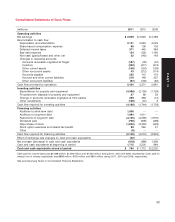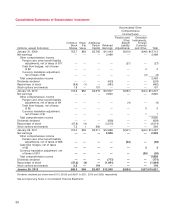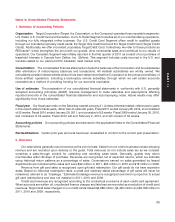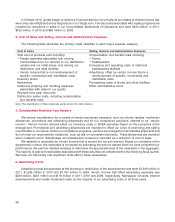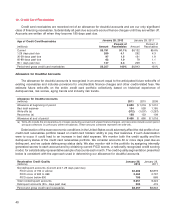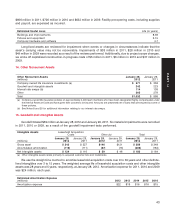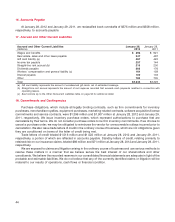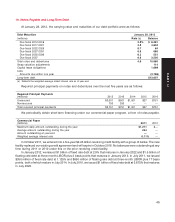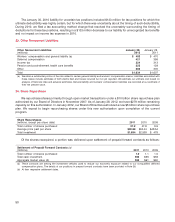Target 2011 Annual Report Download - page 65
Download and view the complete annual report
Please find page 65 of the 2011 Target annual report below. You can navigate through the pages in the report by either clicking on the pages listed below, or by using the keyword search tool below to find specific information within the annual report.
Under certain circumstances, we offer cardholder payment plans that meet the accounting definition of a
troubled debt restructuring (TDR). These plans modify finance charges, minimum payments and/or extend
payment terms. Modified terms do not change the balance of the loan. These concessions are made on an
individual cardholder basis for economic or legal reasons specific to each individual cardholder’s circumstances.
Cardholders are not allowed additional charges while participating in a payment plan. As of January 28, 2012, and
January 29, 2011, there were 118 thousand and 151 thousand modified contracts with outstanding receivables of
$276 million and $400 million, respectively.
Troubled Debt Restructurings
(millions) 2011 2010 2009
Average receivables $330 $445 $526
Finance charges 20 30 39
Troubled Debt Restructurings Defaulted During the Period (a)
(dollars in millions, contracts in thousands) 2011 2010 2009
Number of contracts 13 28 59
Amount defaulted (b) $37 $ 96 $199
(a) Includes loans modified within the twelve months prior to each respective period end.
(b) Represents account balance at the time of default. We define default as not paying the full fixed payment amount for two consecutive
billing cycles.
Receivables in cardholder payment plans that meet the definition of a TDR are treated consistently with other
receivables in determining our allowance for doubtful accounts. Accounts that complete their assigned payment
plan are no longer considered TDRs. Payments received on troubled debt restructurings are first applied to finance
charges and fees, then to the unpaid principal balance.
Funding for Credit Card Receivables
As a method of providing funding for our credit card receivables, we sell, on an ongoing basis, all of our
consumer credit card receivables to Target Receivables LLC (TR LLC), formerly known as Target Receivables
Corporation (TRC), a wholly owned, bankruptcy remote subsidiary. TR LLC then transfers the receivables to the
Target Credit Card Master Trust (the Trust), which from time to time will sell debt securities to third parties, either
directly or through a related trust. These debt securities represent undivided interests in the Trust assets. TR LLC
uses the proceeds from the sale of debt securities and its share of collections on the receivables to pay the
purchase price of the receivables to the Corporation.
We consolidate the receivables within the Trust and any debt securities issued by the Trust, or a related trust, in
our Consolidated Statements of Financial Position. The receivables transferred to the Trust are not available to
general creditors of the Corporation.
During 2006 and 2007, we sold an interest in our credit card receivables by issuing a Variable Funding
Certificate. Parties who hold the Variable Funding Certificate receive interest at a variable short-term market rate.
The Variable Funding Certificate matures in 2012 and 2013.
In the second quarter of 2008, we sold a 47 percent interest in our credit card receivables to JPMorgan Chase
(JPMC). Under the terms of this arrangement, TR LLC repaid JPMC $226 million and $566 million during 2011 and
2010, respectively. In addition, we repaid the remaining principal balance on the note payable to JPMC in January
2012, including a make-whole premium, for $2,854 million, resulting in an $87 million loss on early retirement of
debt, which was recorded within interest expense and excluded from segment profit.
All interests in our Credit Card Receivables issued by the Trust are accounted for as secured borrowings.
Interest and principal payments are satisfied provided the cash flows from the Trust assets are sufficient and are
nonrecourse to the general assets of the Corporation. If the cash flows are less than the periodic interest, the
available amount, if any, is paid with respect to interest. Interest shortfalls will be paid to the extent subsequent cash
41
PART II




